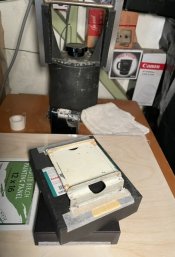Suppose that your enlarger has an elevator or crank so that you raise and lower the head of the enlarger as you grain focus.
Hypothetically you may find a discrepancy between the elevation at which one stops if focusing on the way up, versus focusing on the way down. A few iterations can rule out user mistakes.
And I would say that discrepancy may indicate a critical range within which all planes will produce a sharp print.
Anyone willing to try this and share their results?
Raising and lowering the head - wouldn't that also move the film? As in, that would keep the film to lens distance the same as the enlarger was adjusted?
I'd rather think of it as film and easel being two fixed points and the lens has one exact location between them that is absolutely correct. That a range of locations above and below that location will produce visually indistinguishable enlargements is a function of how a lens works at a certain aperture. There is no lens with an aperture large enough to completely eliminate that range and I doubt there is a lens with an aperture large enough to produce a range less than the thickness of paper.
I've done lots of looking through a grain focuser with paper under it and not under it these past few days. I'm getting hyperopic as I get older and this is speeding up the process.




